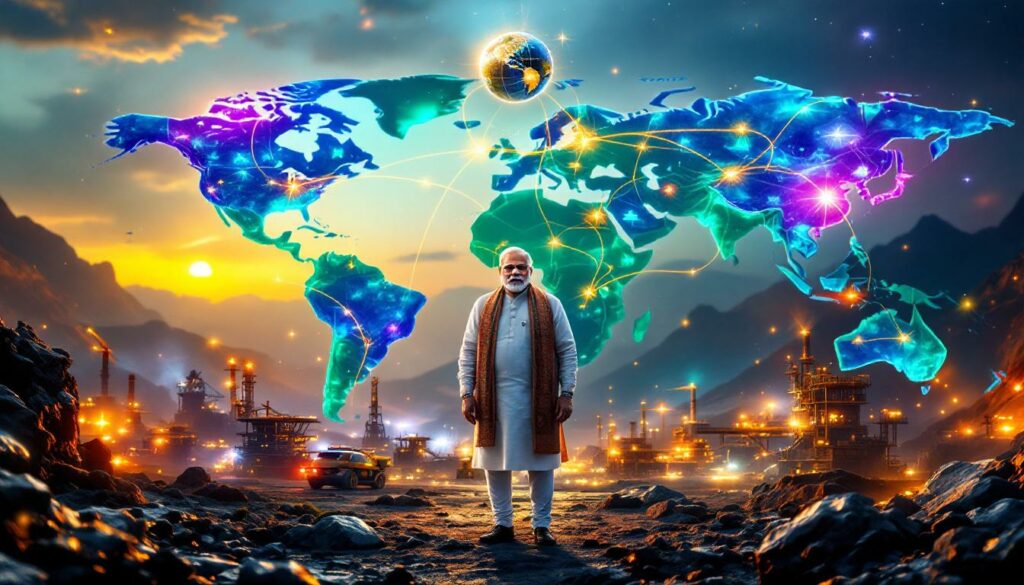India's Critical Minerals Diplomacy: Securing a Resource-Rich Future
India's pursuit of critical minerals has become a cornerstone of its foreign policy, with Prime Minister Narendra Modi embarking on an ambitious five-nation diplomatic tour. This strategic initiative comes at a crucial time when global supply chains face unprecedented challenges, particularly due to China's growing restrictions on rare earth exports. Let's explore how India is navigating this complex landscape to secure its industrial future.
The Strategic Imperative Behind India's Critical Minerals Push
China's Export Restrictions Create Vulnerabilities
China, the world's largest producer of rare earth elements, has begun implementing export restrictions on these vital minerals and rare earth magnets, wielding its dominance for geopolitical leverage. According to recent reports from Mining.com (June 30, 2025), these export curbs are causing significant concern among Indian manufacturers, particularly automakers who fear disruptions to their production lines.
The impact extends beyond the automotive sector to virtually all high-tech manufacturing, from smartphones to renewable energy systems. With China controlling approximately 60% of global rare earth mining and an even higher percentage of processing capacity, India's vulnerability has become impossible to ignore.
"China's strategic control over critical minerals markets represents perhaps the most significant resource monopoly of the 21st century, affecting everything from defense systems to clean energy transition." — Mining industry analysis
India's Accelerating Industrial Demand
India's rapid industrialization and technological advancement have created an insatiable appetite for critical minerals. The country's ambitious goals in several sectors are driving this demand:
- Electric vehicle manufacturing – Targeting 30% of new vehicle sales by 2030
- Renewable energy expansion – Aiming for 500 GW of non-fossil fuel capacity by 2030
- Defense technology sovereignty – Reducing dependence on imported systems
- Electronics manufacturing – Positioning India as a global production hub
These initiatives require stable access to rare earth elements, lithium, cobalt, nickel, and other energy transition minerals. Without secured supply chains, India's industrial growth faces significant constraints and potential disruptions.
Modi's Five-Nation Tour: A Strategic Mineral Expedition
Carefully Selected Resource-Rich Partners
Prime Minister Narendra Modi's five-nation tour, commencing June 30, 2025, represents a carefully calculated diplomatic initiative targeting countries with significant critical mineral deposits:
| Country | Key Critical Mineral Resources | Strategic Importance |
|---|---|---|
| Ghana | Manganese, bauxite, iron ore | Growing West African mining hub |
| Namibia | Uranium, rare earths, lithium | Unexploited critical mineral potential |
| Brazil | Niobium, tantalum, graphite | World's largest niobium producer |
| Argentina | Lithium, copper, silver | Part of the "Lithium Triangle" |
| Trinidad & Tobago | Natural gas, petrochemicals | Energy security partner |
This selection reflects India's comprehensive approach to securing diverse mineral resources across multiple continents and geological formations.
Diversification Across Continents
The tour's geographic diversity—spanning Africa, Latin America, and the Caribbean—clearly demonstrates India's commitment to avoiding dependency on any single region. This multi-continental approach creates resilience against regional disruptions, whether caused by political instability, climate events, or regulatory changes.
As noted by Mining.com, this strategy positions India to leverage different regional advantages while mitigating supply risks. By establishing relationships with countries at various stages of resource development, India can both secure immediate supplies and develop long-term extraction partnerships.
India's Progress in Securing Critical Mineral Resources
Existing Latin American Foothold
India has already made significant inroads into critical minerals acquisition, particularly in Latin America. According to Dammu Ravi, Secretary for Economic Relations in India's Ministry of External Affairs, "We have achieved good progress in Argentina" (Mining.com, June 30, 2025). This statement suggests that preliminary agreements are already in place, with Modi's visit likely to formalize and expand these arrangements.
The country's focus on Argentina lithium insights has been particularly noteworthy, given Argentina's position within the lithium-rich "Triangle" that also includes Chile and Bolivia.
Current Mining Concessions Portfolio
The Mining.com report confirms that India has secured four mining concessions for rare earths in Latin America through state-owned enterprises Khanij Bidesh India Ltd. (KABIL) and Coal India Ltd. While specific production figures remain confidential, these concessions provide India with direct access to mineral resources outside traditional supply chains.
These established operations serve as proof-of-concept for India's mineral acquisition strategy and provide valuable operational experience that can be applied to future projects in Africa and elsewhere, including potential Namibia uranium mining updates.
India's Corporate Vanguard in Critical Minerals Acquisition
State-Owned Enterprises Leading the Charge
India has deployed several government-owned companies to spearhead its critical minerals strategy:
- Khanij Bidesh India Ltd. (KABIL) – A joint venture between NALCO, HCL, and MECL, established specifically for overseas mineral asset acquisition
- NMDC Ltd. – India's largest iron ore producer, now expanding its portfolio to include critical minerals
- Coal India Ltd. – Diversifying beyond coal to secure critical minerals essential for India's energy transition
These companies operate with government backing and diplomatic support, allowing them to compete effectively against well-established international mining corporations.
Public-Private Partnership Frameworks
While state-owned enterprises secure the upstream resources, India is developing innovative public-private partnership models for downstream processing and manufacturing. This approach allows private sector expertise and capital to complement government diplomatic efforts.
The strategy creates multiple entry points for Indian companies throughout the value chain:
- Government entities secure mining rights
- Public-private partnerships develop extraction infrastructure
- Private sector innovates in processing technologies
- Manufacturers receive preferential access to refined materials
This integrated approach maximizes both resource security and economic benefits for India.
Target Minerals: Beyond Rare Earths
Rare Earth Elements: The Crown Jewels
Rare earth elements remain the highest priority in India's critical minerals and Modi's agenda, particularly those essential for high-tech manufacturing, such as:
- Neodymium and praseodymium – Critical for permanent magnets in electric motors
- Dysprosium and terbium – Used to create heat-resistant magnets
- Lanthanum and cerium – Essential for catalytic converters and glass polishing
These elements, despite their name, are not particularly rare in the Earth's crust but are difficult to extract economically and process in an environmentally sustainable manner.
Comprehensive Critical Minerals Portfolio
India's strategy extends beyond rare earths to encompass a broad spectrum of critical minerals essential for its industrial development:
- Battery minerals: Lithium, cobalt, nickel, graphite, and manganese
- Semiconductor minerals: Silicon, gallium, germanium, and indium
- Industrial minerals: Tantalum, niobium, titanium, and zirconium
- Strategic metals: Platinum group metals, chromium, and tungsten
This comprehensive approach ensures that India addresses vulnerabilities across multiple industrial sectors rather than focusing solely on the most publicized minerals.
Expanding India's Global Critical Minerals Footprint
Active Negotiations Across Multiple Continents
According to Periasamy Kumaran, Secretary in India's Foreign Ministry, "India is speaking with Argentina, Peru and Bolivia to acquire more concessions" (Mining.com, June 30, 2025). These ongoing discussions highlight India's proactive approach to resource diplomacy, particularly in the lithium-rich regions of South America.
The negotiations demonstrate India's willingness to engage in long-term partnerships rather than simple transactional relationships. By investing in exploration and development, India positions itself as a committed partner rather than merely a buyer of finished materials.
African Partnership Development Strategy
The inclusion of Ghana and Namibia in Modi's tour signals India's strategic pivot toward African mineral resources. Dammu Ravi confirmed that "India's state-owned Khanij Bidesh India Ltd. and NMDC Ltd. are looking at partnerships in Africa" (Mining.com, June 30, 2025).
Africa's mineral wealth remains largely underdeveloped, offering significant opportunities for early investors willing to develop infrastructure and processing capabilities alongside extraction operations. India's approach differs from China's by emphasizing:
- Skills development and technology transfer
- Local processing capabilities
- Sustainable mining practices
- Community engagement and benefit-sharing
This approach positions India as an attractive alternative partner for African nations seeking to maximize the long-term value of their mineral resources.
Geopolitical Implications of India's Mineral Strategy
Countering China's Resource Dominance
India's aggressive pursuit of critical minerals agreements serves as a direct counterweight to China's growing control over global supplies. By establishing direct relationships with resource-rich nations, India reduces its vulnerability to Chinese export restrictions while offering producer countries an alternative market.
This strategy aligns with broader international efforts to diversify critical mineral supply chains, including initiatives by the United States, European Union, Japan, and Australia. However, India brings unique advantages to these partnerships, including:
- Extensive experience in mining operations
- Strong historical relationships with developing nations
- Rapidly growing domestic market for finished products
- Commitment to technology transfer and capacity building
South-South Cooperation Framework
Modi's focus on partnerships with developing nations reflects India's longstanding commitment to South-South cooperation. Rather than extractive relationships, India emphasizes mutual benefit and development partnerships.
This approach resonates particularly well with countries that have historically experienced unbalanced relationships with resource-seeking nations. By positioning critical minerals and Modi's agenda within a broader framework of development partnership, India creates more sustainable and politically resilient agreements.
Challenges and Obstacles on India's Critical Minerals Path
Intense Global Competition
India faces formidable competition in its pursuit of critical mineral resources. Major economies including the United States, European Union, Japan, and South Korea have launched similar initiatives with substantial financial backing:
- The U.S. Inflation Reduction Act allocated billions for domestic critical minerals production
- The EU Critical Raw Materials Act established strategic partnerships with resource-rich nations
- Japan's economic security legislation prioritizes critical minerals supply chains
- South Korea's battery manufacturers have secured long-term supply agreements worldwide
This competition intensifies acquisition costs and complicates negotiations, particularly in countries with established relationships with China.
Infrastructure and Technical Hurdles
Developing effective mining operations in partner countries requires significant investment in infrastructure, technical expertise, and environmental management. Many promising mineral deposits remain undeveloped precisely because of these challenges.
India must address several key limitations to fully capitalize on new supply agreements:
- Transportation infrastructure – Many deposits are located in remote regions with limited access
- Processing technologies – Rare earth processing requires sophisticated facilities and expertise
- Environmental management – Sustainable extraction demands advanced waste management systems
- Skilled workforce development – Local capacity building is essential for long-term success
Overcoming these challenges will require substantial investment and technology transfer beyond simple extraction agreements.
"The real value in critical minerals lies not in mining alone, but in developing the entire value chain from extraction through processing to manufacturing. Countries that master this integration gain true resource security." — Mining industry perspective
Looking Ahead: India's Critical Minerals Future
Near-Term Milestones and Expectations
Modi's five-nation tour represents a pivotal moment in India's critical minerals and Modi's agenda, with several concrete outcomes anticipated:
- Formalization of existing preliminary agreements
- Announcement of new exploration licenses
- Establishment of joint development frameworks
- Creation of technical cooperation mechanisms
- Initiation of feasibility studies for processing facilities
These deliverables will provide tangible evidence of progress while establishing frameworks for longer-term development.
Long-Term Strategic Vision
India's critical minerals strategy extends far beyond immediate supply concerns to encompass a comprehensive vision for resource security and industrial development:
- Domestic processing capacity to reduce dependence on foreign refiners
- Research and development in recycling and material efficiency
- Alternative materials research to reduce dependence on the most constrained minerals
- Circular economy initiatives to recover critical minerals from waste streams
Furthermore, India is actively pursuing mining industry innovation to improve extraction efficiency and reduce environmental impacts.
Disclaimer: This analysis contains forward-looking statements about India's critical minerals strategy and potential outcomes of diplomatic initiatives. Actual results may vary based on geopolitical developments, market conditions, and technical factors beyond current prediction.
Critical Minerals Diplomacy: Key Takeaways
India's approach to critical minerals diplomacy represents a sophisticated response to growing resource nationalism and supply chain vulnerabilities. By diversifying suppliers across continents, engaging directly with resource-rich nations, and deploying state-owned enterprises as the vanguard of acquisition efforts, India is creating a more resilient mineral supply network.
Modi's five-nation tour signals India's commitment to securing the resources necessary for its continued industrial development and technological advancement. The focus on rare earth elements and other critical minerals addresses a crucial vulnerability in India's manufacturing ecosystem while potentially reshaping global resource partnerships.
As global competition for critical minerals intensifies, India's strategy of combining diplomatic outreach, state-owned enterprise investment, and public-private partnerships provides a template for comprehensive resource security in an increasingly constrained global environment.
Ready to Identify the Next Major Mineral Discovery?
Discover why significant mineral findings can lead to extraordinary market returns with Discovery Alert's proprietary Discovery IQ model, which delivers real-time notifications on ASX mineral discoveries, instantly transforming complex data into actionable investment insights. Visit Discovery Alert's dedicated discoveries page today to see historic examples of exceptional outcomes and begin your 30-day free trial.




